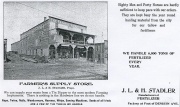|
| |||||
J.L. & H. Stadler Rendering and Fertilizer Co.
From Brooklyn Centre Wiki

J.L. & H. Stadler Rendering and Fertilizer factory during the devastating flood of 1913 on the Cuyahoga River.
Owners:
- John L. and Henry Stadler
Location:
- 124 to 136 Denison Avenue (old style addressing pre-1906).
HISTORY
- J.L. & H. Stadler Rendering and Fertilizer manufactured grease, field manure, and high grade fertilizer from waste material and dead animals collected from all around Cleveland as well as from the Cleveland Union stock yards.
- Another plant of theirs, Farmer's Chemical and Fertilizer, was located on the adjoining property.
- In 1917, bones could cost around 1/2 cents per pound. Shop fats around 3 to 5 cents per pound.[1]
- Many of the residents who lived on Jennings Avenue and the adjacent neighborhood now known as Barbarowa were employed here.
- In addition, the Stadlers also ran the Farmer's Supply Store on Pearl Street in South Brooklyn. Farmer's could obtain virtually everything needed from major equipment such as buggies, wagons, sleighs, harnesses, and feed mills, to tools and appliances.
- The owners, John L. and Henry Stadler, (brothers of August W. Stadler and sons of Ludwig and Dora) also had stables on West 14th Street on the south side of Denison Avenue just behind the property that later housed Mike's Gulf Station.
GAS and OIL BOOM
- A well completed January 30, 1914 obtained gas from the Newburg sand (a porous layer of dolomite)[2] . The initial flow was for 12,500,000 cu.ft. and eventually 68 additional wells could be found in the immediate area.[3] Stadler's success with his well actually started the gas boom in the Cleveland area thanks to the thickness of his gas field which wasn't always the case in other areas. In any case, the gas ran out by 1915.
REFERENCES
- ↑ Food investigation : report of the Federal trade commission on the meat ... By Office of Farm Management and Farm Economics, Bureau of Animal Industry, Federal Trade Commission, Bureau of Markets, United States; pg 184
- ↑ Newburg sand was also referred to as Stadler sand. The gas pool near the Cuyahoga River and mouth of Big Creek was known as the Brooklyn pool. Wells drilled here had an average depth of 2,400 feet with the typical well costing around $5,000 to drill using a derrick and cable tools. See also: Transactions By American Institute of Mining Engineers, Metallurgical Society of AIME, Society of Mining Engineers of AIME., Society of Petroleum Engineers of AIME., Society for Mining, Metallurgy, and Exploration (U.S.). pages 835-836
- ↑ Contributions to Economic Geology (short Papers and Preliminary Reports), 1917 By F. L. Ransome, E F Burchard, Hoyt S Gale, David White, Geological Survey (U.S., Geological Survey (U.S.)
Help support this website by visiting some of the Ads provided by Google.

